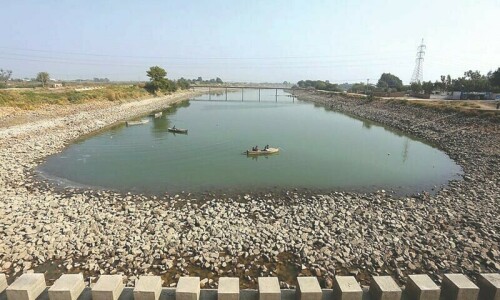KARACHI: There is the terbooz, kherbooza, garma, sarda, and in English all can be wrapped into the melon family. Still there are categories and differences such as honeydew, cantaloupe and watermelons. As the mercury rises fruit shops stock more and more of these. Refreshing flavour-wise and nutritious health-wise, they are considered the best fruit choice for the summer.
All over the city these days you see oblong dark-green watermelons. “The round ones will come a month later,” say fruit sellers when you inquire about the regular variety. But they promise that the oblong ones are as sweet as the round ones. “What difference does the shape make? All are sweet. In Japan, you have the cube-shaped watermelon. So what? The Madina watermelon is small and round, the local one is big and round. What really matters should be its taste and health benefits, not its shape. It’s Rs30 per kg. Have some,” says Jafar Khan, surrounded by big fat watermelons on the footpath of Empress Market.
According to experts, a watermelon, which comprises 92 per cent water, also consists of nutrients such as vitamins A, B6 and C with amino acids, antioxidants and lycopene. A bowl of watermelon carries just around 40 calories so the fruit isn’t fattening in any way. Vitamin A, as everyone knows, is good for the vision, especially night vision. Vitamin B6 is great for the metabolism and good for the hair, skin, eyes and liver and Vitamin C, besides other things, helps the immune system. Amino acids also help immunity with repairing tissue and muscle while antioxidants protect against cancer as does lycopene.
 |
| Oblong watermelons. The light-coloured patches is where they didn’t get sunlight when growing on the vine. |
On fruit carts everywhere you also see the smaller varieties of melon called the kherbooza, also known as honeydew and cantaloupe.
The honeydew is smooth and light-green, yellow or off-white on the outside and orange or off-white inside with a ball of seeds in the middle. When cut into slices, the top layer is the sweetest and juiciest and the nearer you go towards the peel, the blander it tastes.
The cantaloupe is of a similar size. But it has these stripes and a slightly rough exterior. It is also a rich source of vitamins A and C and antioxidants.
 |
| The small garma, claimed to always turn out sweet. |
The kherbooza season in Karachi starts around the beginning of March and goes on till after July. Its musky aroma itself is enough to pull one towards the fruit sellers’ cart. Honeydew is Rs30 a kilogram and cantaloupe Rs50 a kg, according to the sellers. “But you can have 4kg honeydews for Rs100 and 3kg cantaloupe for Rs120,” Abdullah, another fruit seller at Burnes Road shouts out his deal.
 |
| Cantaloupe or the common striped kherbooza as we know it here. |
As for the garma and sarda, well, they are known to be oblong and quite big, but these days you see a much smaller variety of these in the market. “Baji, this is also garma, but slightly smaller in size. The best thing about it is that you’ll always find it sweet. Hungry or thirsty, it’ll help you both ways,” says the man selling these on his cart at Rs40 a kg.
 |
| Every other fruit cart these days is selling a melon of some kind. |
“Almost all the melon dealers say that they are grown in Sindh but the reality is that you can grow them anywhere and even in Karachi. We got this Madina watermelon that was not sweet at all, so my mother-in-law just threw it out in our backyard. Now we have a big watermelon vine there on which the sweetest watermelons grow as if the plant is trying to apologise for the one it grew out from,” says Ms Tariq Yousuf, a resident of Seaview Township in DHA Phase VI. “My kids call the fruit ‘elephant eggs’,” she says and chuckles. “All we do is water the creeper that’s spreading on the ground and turn the fruit over once in a while when it is growing so that all its sides receive equal air and sunlight.”
Published in Dawn, April 12th, 2015
On a mobile phone? Get the Dawn Mobile App: Apple Store | Google Play
















































